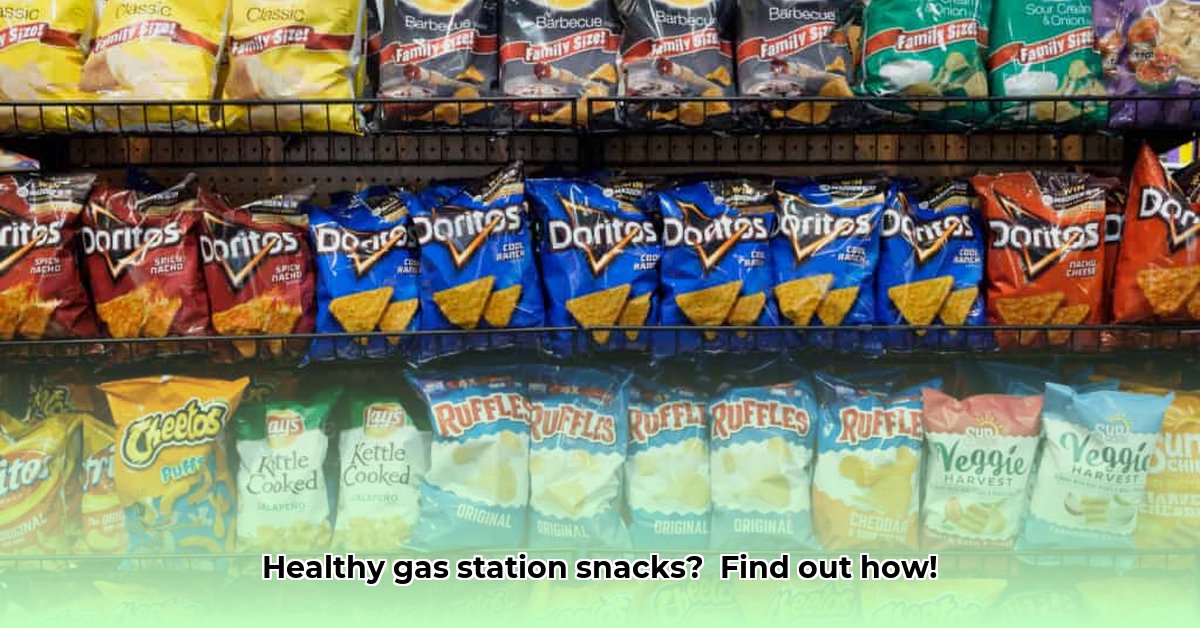Let’s face it: gas station snacks aren’t exactly known for being healthy. But road trips happen, and sometimes a quick stop is all you’ve got. This guide is your secret weapon for finding good-for-you snacks at those unexpected pit stops. We’ll show you how to read nutrition labels like a pro, spot the healthy choices hiding among the junk food, and even plan ahead so you’re never caught unprepared. Get ready to ditch the sugary drinks and processed goodies and discover surprisingly healthy options on your next adventure!
Smart Choices: Your On-the-Go Nutrition Insights
Let’s face it: grabbing a quick bite at a gas station often feels like choosing between a sugar rush and a salt bomb. But healthy eating on the road is possible! This guide will help you navigate the snack aisle and make choices that fuel your body without derailing your healthy habits. We’ll decode nutrition labels, explore readily available healthy options, and armed you with strategies for success.
Learn to Deciphering the Nutrition Label Code for Healthier Choices
Nutrition labels might seem confusing, but they’re your secret weapon for making informed choices. Let’s break down the key players:
- Serving Size: This is HUGE. A “single serving” bag of chips might actually contain two servings, meaning double the calories, fat, and sodium than you initially thought. Always check this first!
- Calories: Aim for snacks under 200 calories per serving to keep things manageable.
- Fats: Pay attention to total fat, saturated fat, and trans fat. Saturated and trans fats, often found in processed goodies, aren’t your friends. Unsaturated fats from sources like nuts and avocados are a much better bet.
- Sodium: Watch out for high sodium levels, especially if you’re watching your blood pressure.
- Sugars: Focus on total sugars and added sugars. “Added sugars” are empty calories—sugars added during processing, not naturally occurring in the food. Aim for less than 5 grams of added sugar per serving.
- Protein and Fiber: These are your fullness buddies. Protein and fiber help you feel satisfied and prevent those mid-afternoon energy crashes. Look for snacks that boast a decent amount of both.
Explore Your Gas Station Snack Powerhouse: Healthy Choices Abound!
You might be surprised by the number of unexpectedly healthy options you can find at most gas stations. Here are some to watch for:
- Fresh Fruit: Apples, bananas, oranges, and even grapes are usually available and provide natural sweetness and fiber to stave off hunger. Look for pre-cut fruit cups for easy snacking.
- Nuts and Seeds: Trail mix (just double-check for excessive added sugar!), almonds, pistachios, sunflower seeds, or even peanuts are packed with protein and healthy fats—great for sustained energy. Opt for unsalted varieties when available.
- Greek Yogurt: A protein powerhouse! Just be sure to pick a plain or low-sugar variety to avoid hidden sugars. Add your own fruit or a sprinkle of nuts for flavor.
- Hard-boiled Eggs: If available, these are a fantastic source of protein that offers lasting energy. Pair with a piece of fruit or some whole-wheat crackers for a balanced snack.
- Tuna or Chicken Pouches: These make for a quick and protein-rich meal replacement when you need something a bit more substantial. Choose those packed in water, not oil, to save on calories.
- Protein Bars: This one requires careful scrutiny. Read the label very closely! Aim for protein bars with at least 10 grams of protein and minimal added sugars and artificial ingredients. Many protein bars are high in sugar and lack the nutritional value you’d hope for. Some experts advise to check the ingredient list and only choose options with primarily whole food ingredients. Ongoing research continues to assess the optimal balance of macronutrients and ingredients in protein bars for optimal health benefits. Look for brands like RXBAR or KIND Protein, which tend to have cleaner ingredient lists.
- Popcorn: Air-popped or lightly salted popcorn can be a good source of fiber and a relatively low-calorie snack.
- Beef or Turkey Jerky: A high-protein option that can keep you feeling full for hours. Watch the sodium content, as some varieties can be very high.
- Hummus and Veggie Sticks: Some gas stations are now offering pre-packaged hummus with carrot sticks or celery. This is a great source of protein, fiber, and healthy fats.
Avoid The Snack Traps: Pitfalls to Sidestep
Not everything glittering in the gas station is gold! Avoid these common culprits:
- Sugary Drinks: Soda, energy drinks, and overly sweetened juices are loaded with empty calories and will likely lead to a mid-afternoon crash. Water is your best friend here. Opt for sparkling water or unsweetened tea if you want something other than plain water.
- Processed Snacks: Most chips, cookies, candy bars, and pastries are high in unhealthy fats, added sugar, and sodium. These offer minimal nutritional value and usually leave you feeling unsatisfied shortly after.
- Super-Sized Portions: Even healthy snacks can become unhealthy if you consume massive amounts. Practice portion control. Buy single-serving packages whenever possible.
- Candy: It may seem obvious, but candy offers little to no nutritional value and is packed with sugar. If you’re craving something sweet, opt for a piece of fruit or a small square of dark chocolate.
Winning Strategy: Your Road Trip to Healthy Snacking Starts Here
Here’s how to make healthy gas station snacking a consistent part of your routine:
- Pre-trip Prep: Pack your own snacks whenever feasible. This gives you complete control over what you’re eating. Cut up vegetables, portion out nuts, and fill a water bottle.
- Label Literacy: Don’t just grab the first flashy package. Take a few seconds to check the nutrition facts panel.
- Smart Choices: Opt for minimally processed snacks. The shorter the ingredient list, the better.
- Reality Check: You won’t always find perfect health food at every gas station. Sometimes, you’ll need to make the best possible choice out of what’s available.
- Portion Power: Even healthy snacks should be enjoyed in moderation.
- Hydrate: Always carry a water bottle and refill it at every stop. Dehydration can often be mistaken for hunger.
Deep Dive: Protein Bars – A Quick Assessment Guide
It’s worth spending a moment to carefully analyze protein bars, as these are a common choice for those looking for a quick energy boost. There’s some debate about the ideal protein bar, and ongoing research is investigating long-term health impacts. Here’s a quick guide to assessing them:
| Feature | Excellent | Good | Fair | Poor |
|---|---|---|---|---|
| Protein (grams/serving) | ≥15g | 10-14g | 7-9g | <7g |
| Added Sugar (grams/serving) | ≤5g | 5-7g | 8-10g | >10g |
| Ingredients | Primarily whole foods, minimally processed | Mostly recognizable ingredients | Some unrecognizable ingredients | Many artificial ingredients |
Remember: Making smart choices can transform even a quick gas station stop into a healthy experience. Healthy eating shouldn’t stop when you hit the road!
Tips to Find the Healthiest Protein Bars at Gas Stations
Key Takeaways:
- Reading nutrition labels is crucial for making informed choices.
- Prioritize protein bars with lower sugar and sodium content.
- Compare different brands and products within the gas station.
- Consider portion control to avoid overconsumption.
- Pre-planning your snacks helps you avoid impulsive unhealthy choices.
Understand How to Deciphering the Nutrition Label Maze
Before you even think about grabbing a protein bar, let’s talk labels. They’re your secret weapon! Think of them as a nutritional roadmap. What should you look for?
- Serving Size: This is crucial. Many bars have multiple servings, so check carefully.
- Calories: Aim for bars around 200 calories or less per serving, unless your goals are different.
- Protein: Look for at least 10-15 grams of protein per serving. This will help you feel full and satisfied.
- Sugar: Less is more. Aim for less than 10 grams of sugar. High sugar counts sneak up on unsuspecting shoppers!
- Fiber: Fiber adds volume to your snack, which enhances satiety. 5 grams or more is a good target.
- Sodium: High sodium levels can lead to bloating. Look for lower sodium content.
- Fat: Pay attention to the type of fat. Unsaturated fats are preferable to saturated and trans fats.
Spotting the Best Protein Bars for Healthier Snacking
Okay, now for the fun part: finding those gems. How to find the healthiest protein bars at gas stations involves a bit of detective work. Here’s what to look for:
- Ingredients:
- Achieve Anesthesiology Work-Life Balance: Your Guide - December 4, 2025
- Unlock Young Doctors’ Work-Life Balance: Actionable Strategies Now - December 2, 2025
- Unlock Life Harmony: Work-Life Integration Guide - November 30, 2025
















